Aggressive Behavior: Autistic Children and Teenagers
Effective strategies for handling aggressive behavior in autistic children and teens. Learn how to support and empower your child.

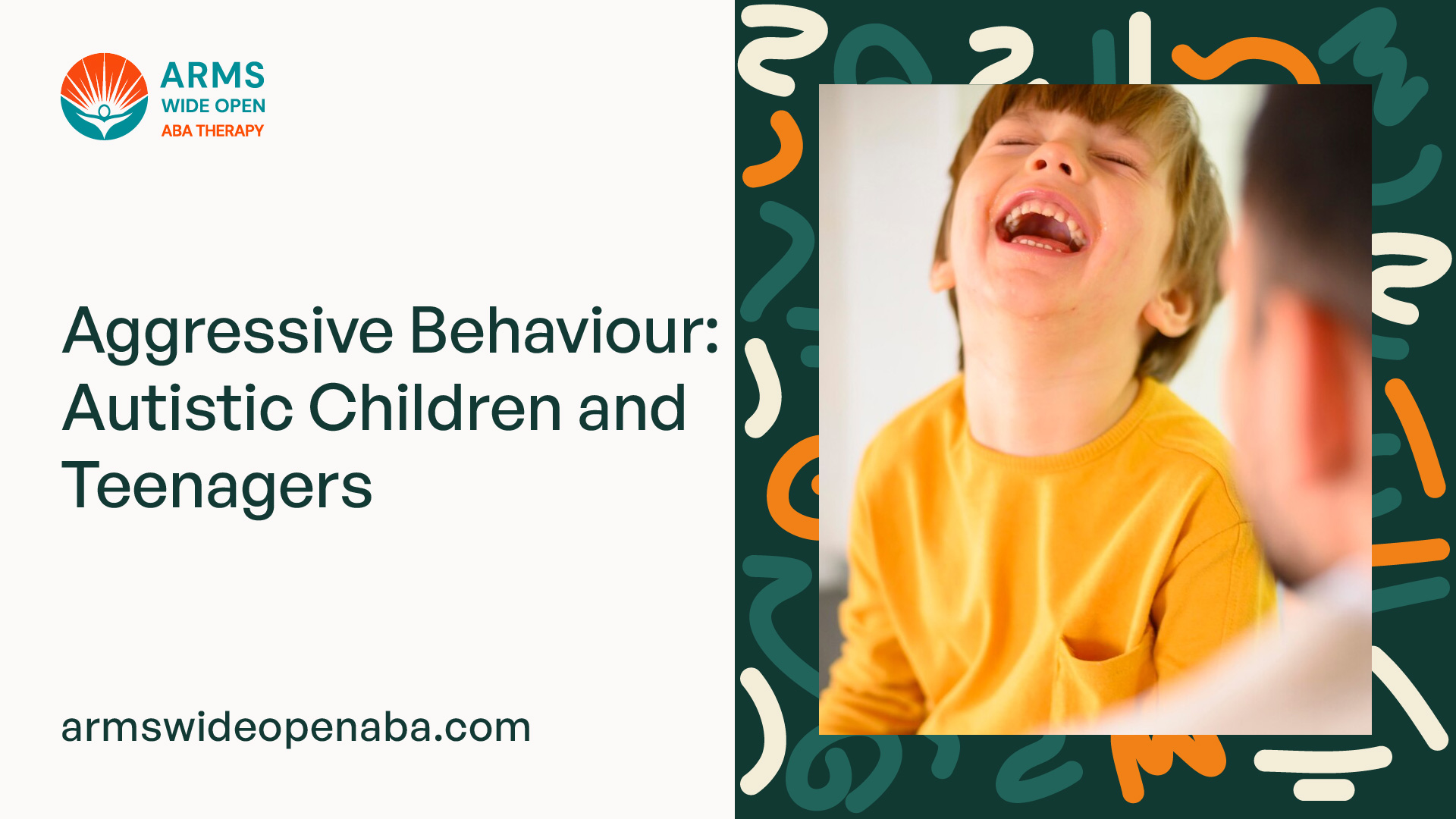
Understanding Aggressive Behavior in Autistic Children and Teens
When it comes to understanding aggressive behavior in autistic children and teenagers, it's essential to recognize the signs and identify the common triggers that may contribute to such behavior. By gaining a better understanding of these factors, parents and caregivers can implement effective strategies to manage and support their child.
Recognizing Aggressive Behavior
Recognizing aggressive behavior in autistic children and teens is crucial for early intervention and support. While the manifestation of aggression may vary from one individual to another, some common signs to look out for include:
- Hitting, kicking, or biting
- Scratching or hair-pulling
- Throwing objects
- Yelling or shouting
- Property destruction
- Self-injurious behaviors
It's important to note that aggressive behavior can be a form of communication for autistic individuals, often stemming from frustration, sensory overload, or difficulty expressing their needs or emotions. By recognizing these behaviors as a means of communication, parents and caregivers can respond in a supportive and understanding manner.
Common Triggers for Aggression
Understanding the common triggers for aggression in autistic children and teens can help parents and caregivers anticipate and manage these situations. While triggers may vary from person to person, some common factors that can contribute to aggressive behavior include:
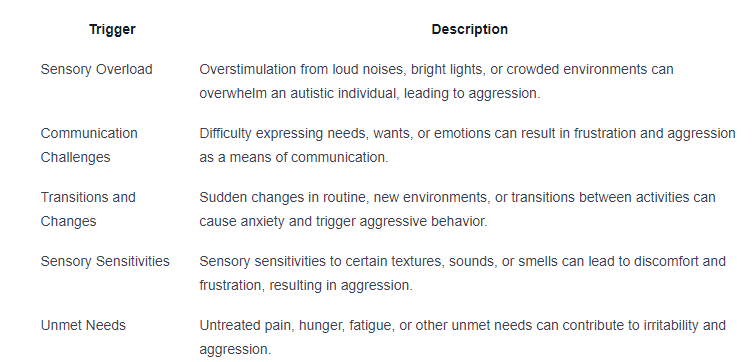
By identifying these triggers, parents and caregivers can proactively create strategies and interventions to minimize the occurrence of aggressive behavior. This may involve providing a predictable and structured environment, teaching coping skills, and addressing sensory sensitivities.
Understanding and recognizing aggressive behavior and its common triggers are crucial steps in supporting autistic children and teens. By focusing on proactive strategies and interventions, parents and caregivers can create a nurturing and supportive environment that promotes positive behavior and enhances the overall well-being of their child.
Strategies for Managing Aggressive Behavior
When it comes to managing aggressive behavior in autistic children and teenagers, employing effective strategies is essential for promoting a safe and supportive environment. Here are three strategies that can be helpful in managing aggressive behavior:
Establishing Routine and Structure
Establishing a consistent routine and structured environment can provide a sense of stability for autistic children and teenagers, which can help reduce aggressive behavior. Creating a visual schedule or using a daily planner can assist in outlining the day's activities and expectations. Breaking tasks into smaller, manageable steps can also alleviate feelings of overwhelm and frustration.
By maintaining a predictable routine, individuals on the autism spectrum can feel more secure and aware of what to expect. This can minimize anxiety and prevent potential triggers for aggression. It is important to communicate the schedule clearly and allow for flexibility when needed to accommodate individual needs.
Implementing Positive Reinforcement
Positive reinforcement is a valuable strategy for managing aggressive behavior. By focusing on rewarding positive actions and behaviors, individuals are encouraged to engage in more appropriate responses. This can help shift the focus from negative behaviors to positive alternatives.
Using a token economy system, where individuals earn tokens or points for desired behaviors, can be an effective way to reinforce positive actions. These tokens can then be exchanged for preferred items or activities. By consistently rewarding positive behaviors, individuals are motivated to engage in them more frequently, reducing the occurrence of aggressive behavior.
Teaching Coping Skills
Teaching individuals on the autism spectrum effective coping skills is crucial in managing aggressive behavior. Providing them with alternative ways to express their emotions and frustration can help prevent aggressive outbursts. Coping skills can include deep breathing exercises, using calming techniques such as visualizations or sensory tools, and engaging in preferred activities when feeling overwhelmed.
It is important to teach and model these coping skills in a calm and supportive manner. Breaking down the steps involved and providing visual prompts can enhance understanding and retention. Regular practice and reinforcement of these skills can empower individuals to manage their emotions and reactions more effectively.
Employing these strategies for managing aggressive behavior can greatly contribute to creating a safer and more nurturing environment for autistic children and teenagers. By establishing routine and structure, implementing positive reinforcement, and teaching coping skills, parents, caregivers, and educators can help individuals on the autism spectrum develop healthier ways of expressing themselves and interacting with others.

Creating a Supportive Environment
When it comes to managing aggressive behavior in autistic children and teens, creating a supportive environment plays a crucial role. By understanding and addressing their unique needs, we can help reduce the occurrence of aggressive episodes. In this section, we will explore three important aspects of creating a supportive environment: sensory considerations, communication strategies, and building trust and connection.
Sensory Considerations
Sensory sensitivities are common among autistic individuals and can often contribute to aggressive behavior. By being mindful of their sensory needs, we can create an environment that minimizes sensory overload and promotes a sense of calm.
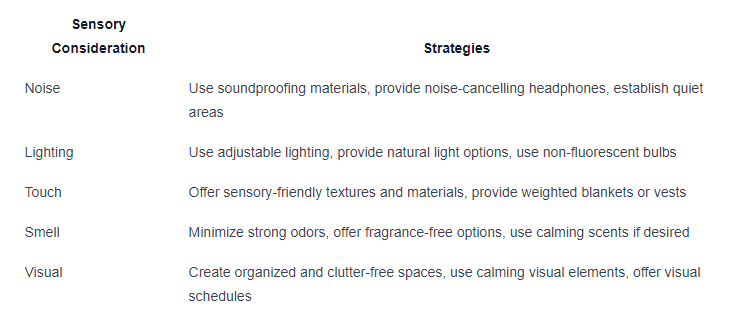
By implementing these sensory considerations, we can create an environment that is more comfortable and accommodating for autistic individuals, reducing the likelihood of aggressive behaviors.
Communication Strategies
Clear and effective communication is essential in managing aggressive behavior in autistic children and teens. By using appropriate communication strategies, we can minimize frustration and help them express their needs and emotions.
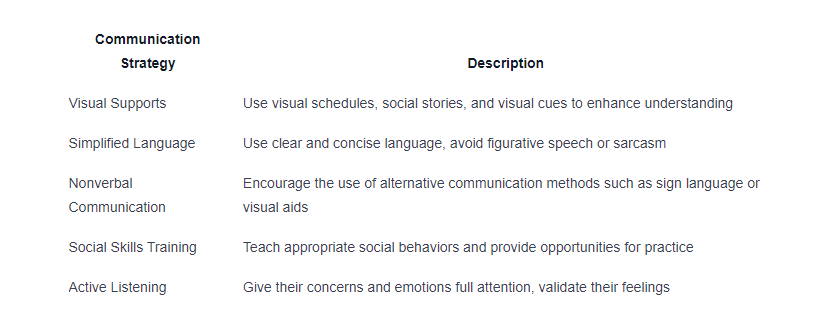
By utilizing these communication strategies, we can establish effective channels of communication and provide the necessary support for autistic individuals, reducing the likelihood of aggressive outbursts.
Building Trust and Connection
Building trust and connection is vital in managing aggressive behavior in autistic children and teens. By nurturing positive relationships, we can help them feel secure and understood, which in turn reduces anxiety and aggression.
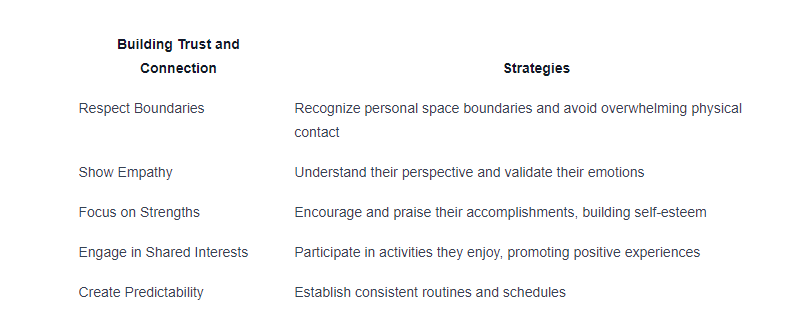
By implementing these strategies, we can foster a supportive and trusting environment, where autistic individuals feel valued and understood. This, in turn, can greatly contribute to reducing aggressive behaviors and promoting overall well-being.
Creating a supportive environment is a key component in managing aggressive behavior in autistic children and teens. By considering sensory needs, using effective communication strategies, and building trust and connection, we can provide the necessary support and promote positive outcomes for these individuals.
Working with Professionals
When it comes to managing aggressive behavior in autistic children and teens, collaborating with professionals can be instrumental in providing effective support and intervention. Therapists and specialists play a crucial role in understanding and addressing the underlying causes of aggression, as well as developing strategies to manage and reduce these behaviors.
Collaborating with Therapists and Specialists
Working with therapists and specialists who have experience in autism and behavior management can provide valuable insights and guidance. These professionals can conduct assessments to identify the triggers and underlying factors contributing to aggressive behavior. They can also help develop individualized behavior plans tailored to the specific needs of the child or teen.
Collaboration with therapists and specialists may involve regular meetings to discuss progress, share observations, and make necessary adjustments to the behavior plan. It is essential to maintain open communication and actively participate in the collaborative process to ensure consistent and effective support for the child or teen.
Seeking Behavioral Interventions
Behavioral interventions are evidence-based strategies designed to modify behavior and teach alternative skills. Applied Behavior Analysis (ABA) is one such intervention that has shown effectiveness in addressing aggressive behavior in individuals with autism. ABA focuses on reinforcing positive behaviors while reducing challenging ones through systematic observation and analysis.
Other behavioral interventions may include cognitive-behavioral therapy (CBT) or social skills training. These approaches can help individuals with autism develop coping strategies, emotional regulation skills, and effective communication techniques.
Medication Considerations
In some cases, medication may be considered as part of a comprehensive treatment plan for managing aggressive behavior in autistic children and teens. However, medication should always be prescribed and monitored by a qualified medical professional, such as a psychiatrist or pediatrician specializing in developmental disorders.
Medication options may include mood stabilizers, antipsychotics, or other medications that target specific symptoms or comorbid conditions. The decision to use medication should be based on a thorough evaluation of the individual's specific needs and in close consultation with the healthcare provider.
It is important to note that medication should not be seen as a standalone solution but rather as one component of a comprehensive approach that includes behavioral interventions, therapy, and support.
Collaborating with therapists and specialists, seeking behavioral interventions, and considering medication options are all important aspects of working with professionals to manage aggressive behavior in autistic children and teens. By taking a multidisciplinary approach, parents and caregivers can access the expertise and support needed to create effective strategies and enhance the overall well-being of their child or teen.
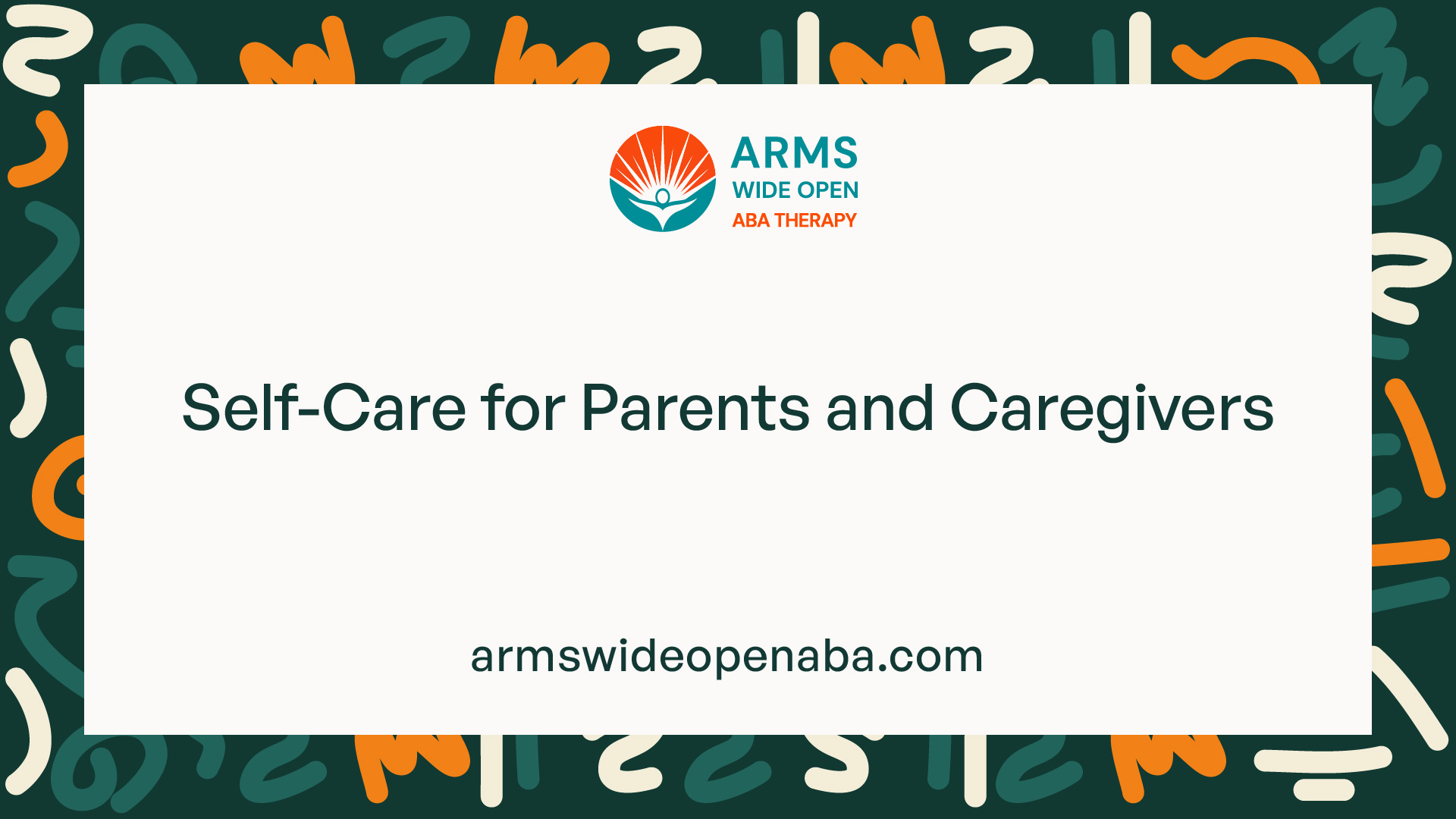
Self-Care for Parents and Caregivers
Taking care of oneself is essential when dealing with the challenges of managing aggressive behavior in autistic children and teens. Parents and caregivers play a crucial role in supporting their children, but it's important to prioritize their own well-being as well. Here are some strategies for self-care:
Managing Stress and Burnout
Caring for an autistic child or teen with aggressive behavior can be emotionally and physically taxing. It's important for parents and caregivers to manage their stress levels and prevent burnout. Here are some tips:
- Take breaks: Schedule regular breaks to recharge and engage in activities that bring you joy and relaxation.
- Practice self-care activities: Engage in activities that help you unwind and reduce stress, such as exercise, meditation, or hobbies.
- Seek respite care: Consider arranging respite care to give yourself a temporary break and time to recharge.
Seeking Support Networks
Building a support network is crucial for parents and caregivers of autistic children and teens. Connecting with others who understand your experiences can provide a sense of belonging and reduce feelings of isolation. Here are some ways to seek support:
- Join support groups: Look for local or online support groups specifically for parents and caregivers of autistic children. These groups offer a safe space to share experiences, seek advice, and gain support.
- Reach out to professionals: Consult therapists, counselors, or support organizations that specialize in autism to gain insights and guidance.
- Connect with other parents: Reach out to other parents or caregivers who have similar experiences. They can offer empathy, understanding, and practical advice.
Practicing Self-Compassion and Patience
Caring for an autistic child or teen with aggressive behavior can be challenging, and it's important to be kind to yourself. Here are some ways to practice self-compassion and patience:
- Acknowledge your efforts: Recognize and appreciate the hard work and dedication you put into caring for your child.
- Be patient with yourself: Understand that it's normal to feel overwhelmed at times. Practice self-compassion and give yourself permission to make mistakes and learn from them.
- Celebrate small victories: Focus on the progress your child makes, no matter how small. Celebrate achievements and milestones along the way.
Taking care of yourself is not selfish; it is necessary for your well-being and your ability to provide the best support for your child. By managing stress, seeking support networks, and practicing self-compassion, parents and caregivers can better navigate the challenges associated with aggressive behavior in autistic children and teens.
Long-Term Planning and Advocacy
When it comes to managing aggressive behavior in autistic children and teens, long-term planning and advocacy are essential for ensuring their ongoing well-being and support. This involves looking ahead and taking proactive steps to address their unique needs and create a sustainable care plan. In this section, we will explore three key aspects of long-term planning and advocacy: transition planning for adolescents, advocating for educational and community support, and building a sustainable care plan.
Transition Planning for Adolescents
As autistic children transition into adolescence, it is important to have a well-thought-out plan in place to support their changing needs. Transition planning involves preparing them for the challenges and opportunities they will encounter as they move into adulthood.
Transition Considerations
Developing self-advocacy skills
Exploring post-secondary education and vocational training options
Identifying community resources and support services
Establishing goals for independent living and employment
Understanding legal rights and protections
By working closely with educators, therapists, and other professionals, parents and caregivers can develop a comprehensive transition plan that addresses these considerations and sets the stage for a successful transition into adulthood.
Advocating for Educational and Community Support
Advocacy plays a crucial role in ensuring that autistic children and teens receive the educational and community support they need. It involves actively seeking out resources, services, and accommodations that can help meet their unique needs and facilitate their development.
Educational and Community Support
Individualized Education Program (IEP) or 504 Plan
Access to specialized therapies and interventions
Peer support programs
Inclusion and accessibility initiatives
Community-based recreational activities
Parents and caregivers can advocate for their children by collaborating with school personnel, attending Individualized Education Program (IEP) or 504 Plan meetings, and staying informed about available support services in their community. By actively engaging in advocacy efforts, they can help create an environment that fosters growth, inclusion, and support for their autistic child or teen.
Building a Sustainable Care Plan
Building a sustainable care plan involves taking a holistic approach to meet the long-term needs of autistic children and teens. This includes addressing their physical, emotional, educational, and social well-being in a comprehensive and consistent manner.
Components of a Sustainable Care Plan
Regular medical and therapeutic evaluations
Ongoing communication with healthcare providers and therapists
Collaborative approach with caregivers, educators, and therapists
Integration of individualized strategies and interventions
Continual assessment and adjustment of the care plan
By establishing a sustainable care plan, parents and caregivers can ensure that their child's needs are consistently met, that strategies are continually evaluated and adjusted as necessary, and that all stakeholders involved in their care are working together to provide the best possible support.
Long-term planning and advocacy are critical components of managing aggressive behavior in autistic children and teens. By focusing on transition planning, advocating for educational and community support, and building a sustainable care plan, parents and caregivers can empower their children to thrive and lead fulfilling lives.
Sources
https://raisingchildren.net.au/autism/behaviour/common-concerns/aggressive-behaviour-asd
https://sparkforautism.org/discover_article/understanding-aggressive-behavior-in-autism/
https://www.autismspeaks.org/autism-and-aggression
Similar articles
We’re here to help you

Our team is here to assist you in this process. Contact us for any assistance.
it’s easy to apply
We Accept Most Insurances
Our in-network insurance partnerships make ABA therapy more accessible to families throughout our service areas.







Our Insurance Process
We'll request your insurance details to help us verify your plan's coverage for ABA therapy. Once we've received this information, we'll walk you through your benefits, including copayments, deductibles and out-of-pocket maximums, so you know what to expect in advance.
Our team will then handle the preauthorization and all the necessary paperwork.
.svg)





















.jpeg)


































.jpeg)




.jpeg)







.jpeg)











.jpeg)
















